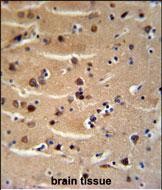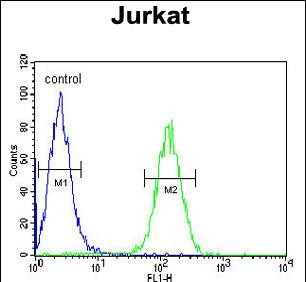AXIN2 Antibody (C-term)
Affinity Purified Rabbit Polyclonal Antibody (Pab)
- SPECIFICATION
- CITATIONS
- PROTOCOLS
- BACKGROUND

Application
| WB, FC, IHC-P, E |
|---|---|
| Primary Accession | Q9Y2T1 |
| Other Accession | O70240, O88566, NP_004646.3 |
| Reactivity | Human |
| Predicted | Mouse, Rat |
| Host | Rabbit |
| Clonality | Polyclonal |
| Isotype | Rabbit IgG |
| Calculated MW | 93568 Da |
| Antigen Region | 816-843 aa |
| Gene ID | 8313 |
|---|---|
| Other Names | Axin-2, Axin-like protein, Axil, Axis inhibition protein 2, Conductin, AXIN2 |
| Target/Specificity | This AXIN2 antibody is generated from rabbits immunized with a KLH conjugated synthetic peptide between 816-843 amino acids from the C-terminal region of human AXIN2. |
| Dilution | WB~~1:1000 FC~~1:10~50 IHC-P~~1:50~100 E~~Use at an assay dependent concentration. |
| Format | Purified polyclonal antibody supplied in PBS with 0.09% (W/V) sodium azide. This antibody is purified through a protein A column, followed by peptide affinity purification. |
| Storage | Maintain refrigerated at 2-8°C for up to 2 weeks. For long term storage store at -20°C in small aliquots to prevent freeze-thaw cycles. |
| Precautions | AXIN2 Antibody (C-term) is for research use only and not for use in diagnostic or therapeutic procedures. |
| Name | AXIN2 |
|---|---|
| Function | Inhibitor of the Wnt signaling pathway. Down-regulates beta- catenin. Probably facilitate the phosphorylation of beta-catenin and APC by GSK3B. |
| Cellular Location | Cytoplasm. |
| Tissue Location | Expressed in brain and lymphoblast. |

Thousands of laboratories across the world have published research that depended on the performance of antibodies from Abcepta to advance their research. Check out links to articles that cite our products in major peer-reviewed journals, organized by research category.
info@abcepta.com, and receive a free "I Love Antibodies" mug.
Provided below are standard protocols that you may find useful for product applications.
Background
The Axin-related protein, Axin2, presumably plays an important role in the regulation of the stability of beta-catenin in the Wnt signaling pathway, like its rodent homologs, mouse conductin/rat axil. In mouse, conductin organizes a multiprotein complex of APC (adenomatous polyposis of the colon), beta-catenin, glycogen synthase kinase 3-beta, and conductin, which leads to the degradation of beta-catenin. Apparently, the deregulation of beta-catenin is an important event in the genesis of a number of malignancies. The AXIN2 gene has been mapped to 17q23-q24, a region that shows frequent loss of heterozygosity in breast cancer, neuroblastoma, and other tumors. Mutations in this gene have been associated with colorectal cancer with defective mismatch repair.
References
Inkster, B., et al. Neuroimage (2010) In press :
Guey, L.T., et al. Eur. Urol. 57(2):283-292(2010)
Couch, F.J., et al. Cancer Epidemiol. Biomarkers Prev. 19(1):251-257(2010)
Hosgood, H.D. III, et al. Respir Med 103(12):1866-1870(2009)
Olschwang, S., et al. J Oncol 2009, 306786 (2009) :
Dong, X., et al. Cytogenet. Cell Genet. 93 (1-2), 26-28 (2001) :
Liu, W., et al. Nat. Genet. 26(2):146-147(2000)
von Kries, J.P., et al. Nat. Struct. Biol. 7(9):800-807(2000)
Kikuchi, A. Cytokine Growth Factor Rev. 10 (3-4), 255-265 (1999) :
Mai, M., et al. Genomics 55(3):341-344(1999)
If you have used an Abcepta product and would like to share how it has performed, please click on the "Submit Review" button and provide the requested information. Our staff will examine and post your review and contact you if needed.
If you have any additional inquiries please email technical services at tech@abcepta.com.













 Foundational characteristics of cancer include proliferation, angiogenesis, migration, evasion of apoptosis, and cellular immortality. Find key markers for these cellular processes and antibodies to detect them.
Foundational characteristics of cancer include proliferation, angiogenesis, migration, evasion of apoptosis, and cellular immortality. Find key markers for these cellular processes and antibodies to detect them. The SUMOplot™ Analysis Program predicts and scores sumoylation sites in your protein. SUMOylation is a post-translational modification involved in various cellular processes, such as nuclear-cytosolic transport, transcriptional regulation, apoptosis, protein stability, response to stress, and progression through the cell cycle.
The SUMOplot™ Analysis Program predicts and scores sumoylation sites in your protein. SUMOylation is a post-translational modification involved in various cellular processes, such as nuclear-cytosolic transport, transcriptional regulation, apoptosis, protein stability, response to stress, and progression through the cell cycle. The Autophagy Receptor Motif Plotter predicts and scores autophagy receptor binding sites in your protein. Identifying proteins connected to this pathway is critical to understanding the role of autophagy in physiological as well as pathological processes such as development, differentiation, neurodegenerative diseases, stress, infection, and cancer.
The Autophagy Receptor Motif Plotter predicts and scores autophagy receptor binding sites in your protein. Identifying proteins connected to this pathway is critical to understanding the role of autophagy in physiological as well as pathological processes such as development, differentiation, neurodegenerative diseases, stress, infection, and cancer.




